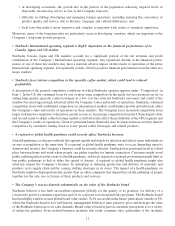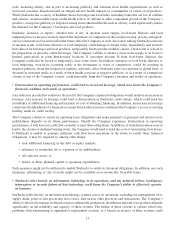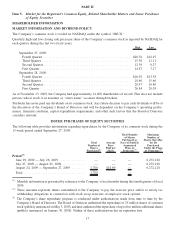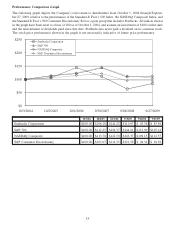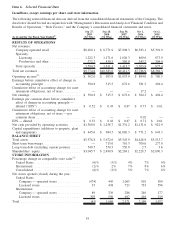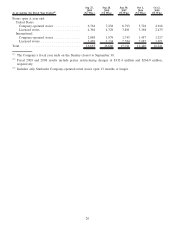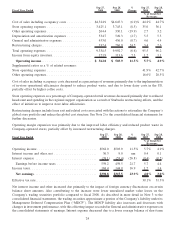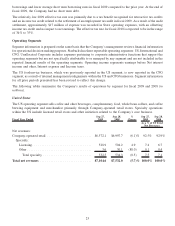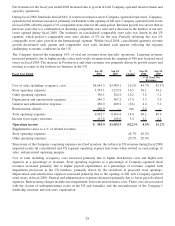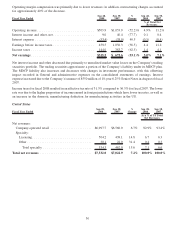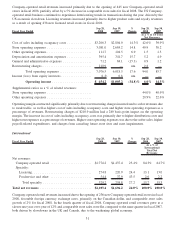Starbucks 2009 Annual Report Download - page 29
Download and view the complete annual report
Please find page 29 of the 2009 Starbucks annual report below. You can navigate through the pages in the report by either clicking on the pages listed below, or by using the keyword search tool below to find specific information within the annual report.Item 7. Management’s Discussion and Analysis of Financial Condition and Results of Operations
General
Starbucks Corporation’s fiscal year ends on the Sunday closest to September 30. The fiscal years ended on
September 27, 2009, September 28, 2008 and September 30, 2007 all included 52 weeks. Starbucks 2010 fiscal year
will include 53 weeks, with the 53
rd
week falling in its fourth fiscal quarter. All references to store counts, including
data for new store openings, are reported net of related store closures, unless otherwise noted.
Overview
Fiscal 2009 was a challenging year for Starbucks. The Company was confronted with extraordinary economic and
operating challenges in addition to facing an increasingly competitive landscape. Although the global economy has
shown some signs of improvement recently, management recognizes the difficult economic situation that many
consumers are still facing and does not expect that to significantly change over the course of fiscal 2010. This
challenging economic environment has strained consumer discretionary spending in the US and internationally,
which in turn has impacted Company revenues, comparable store sales, operating income and operating margins.
Starbucks responded to this difficult environment with a more disciplined focus on operations and the introduction
of initiatives to permanently improve the Company’s cost structure. The result is an underlying business model that
is less reliant on high revenue growth to drive profitability, and that still preserves the fundamental strengths and
values of the Starbucks brand. The primary initiatives in this strategy include rationalizing the global Company-
operated store portfolio, right-sizing the non-retail support organization, and reducing the Company’s cost
structure, while renewing the focus on service excellence in the stores and delivering relevant innovation.
Starbucks actions to rationalize its global store portfolio have included the planned closure of nearly 1,000
Company-operated stores globally. At the end of fiscal 2009, nearly all of the approximately 800 US Company-
operated stores, 61 stores in Australia and 41 Company-operated stores in other International markets had been
closed. The remaining International store closures are expected to be completed by the end of fiscal 2010.
Initiatives targeting reductions in the Company’s cost structure in fiscal 2009 proceeded as planned, with full-year
costs of $580 million removed from the Company’s cost structure. These targeted cost reductions and associated
operational efficiency efforts, along with a more profitable Company-operated store base, have moved Starbucks
toward a more sustainable business model, while preserving the fundamental strengths and values of the brand. The
operational efficiency efforts are primarily focused on store level execution and include improved staffing models
and better management of waste in coffee, dairy and food.
Starbucks actions to improve the customer experience have resulted in a more focused effort toward in-store
offerings, and simplifying the demands on store partners (employees), while concurrently raising already-high
standards for beverage and food offerings, customer service and the overall in-store experience. The effects of these
efforts have already been seen in the Company’s improved customer satisfaction scores.
Starbucks has a renewed focus on relevant product innovation and the disciplined expansion and leveraging of its
existing products and sales channels. For example, Starbucks VIA
TM
Ready Brew coffee was launched in fiscal 2009
and is designed to capture a significant share of both the $21 billion global instant coffee category and the single-
serve market. The Company intends to drive sales within the retail store base and CPG channels, both in the US and
internationally.
The Company continues to maintain a solid financial foundation, with no short term debt outstanding at the end of
fiscal 2009 and with cash and liquid investments totaling more than $650 million. This solid financial position and
continued strong cash flow generation have provided Starbucks with the financial flexibility to implement its
restructuring efforts as well as make ongoing investments in its core business.
Fiscal 2010 — The View Ahead
For fiscal 2010, the Company expects revenues to grow in the low-to-mid single digits compared to fiscal 2009,
driven by modestly positive comparable store sales, a 53
rd
fiscal week, and approximately 100 planned net new
21


